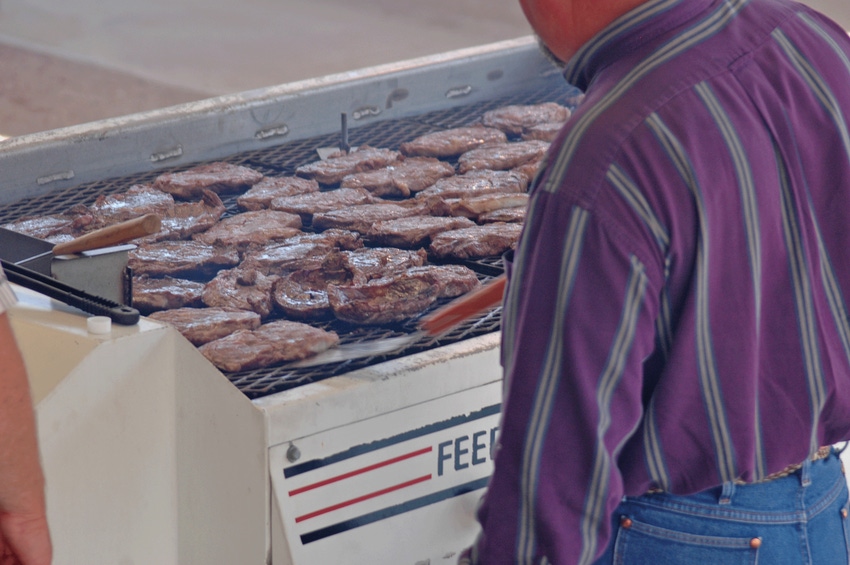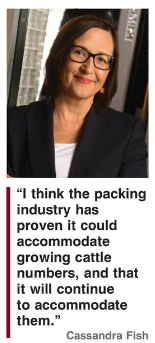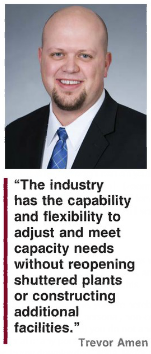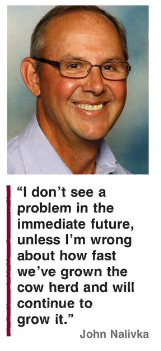While beef packing capacity appears sufficient, the expanding cowherd and increasing capacity use suggest there is less room for error than a decade ago.
November 2, 2017

As the nation’s beef cowherd continues to expand — broader and longer than some anticipated — some producers wonder whether beef packing capacity is enough.
You know the conversation: “They closed Emporia [Kan.], then Plainview [Texas] … remember when hogs ran short on shackle space and they were worth about $4 a head?”
First, the bottom line.
Notwithstanding some sort of calamity, such as a widespread, multi-year drought or a major packing plant burning to the ground, beef packing capacity appears sufficient, based on various estimates and measures. In fact, increased capacity use suggests the most robust health for the packing sector in more than 10 years.
Keep in mind that total actual or estimated beef slaughter capacity is the product of steer and heifer slaughter capacity (fed cattle) and capacity for killing cull cows and bulls (non-fed cattle). This article focuses specifically on fed cattle capacity.
“I’m really optimistic,” says Cassandra Fish, a private consultant who provides domestic and international clients — including cattle feeders and meat packers—with analyses and risk assessment. “I think the packing industry has proven it could accommodate growing cattle numbers, and that it will continue to accommodate them.” Fish also writes the daily market commentary blog The Beef.
“I don’t think we’re anywhere near capacity,” says Derrell Peel, Extension livestock marketing specialist at Oklahoma State University. “I don’t think we have an immediate issue with packing capacity, and I certainly don’t think we’ve had any issue in the last 18 months that impacted the market.” He’s referring to the suggestion made by some that packing capacity contributed to last fall’s price collapse.
“There continues to be some excess capacity out there,” says John Nalivka, president of Sterling Marketing Inc. at Vale, Ore. “I don’t see a problem in the immediate future, unless I’m wrong about how fast we’ve grown the cow herd and will continue to grow it.”
“We had the largest fed cattle kill for September since 2010 without any disruption, and I think that’s a good indicator,” says Trevor Amen, animal protein economist for CoBank.
“We do not expect significant constraints on packing capacity during this expansion. The industry has the capability and flexibility to adjust and meet capacity needs without reopening shuttered plants or constructing additional facilities,” Amen says.
With that said, as drought-forced herd liquidation compelled packers to shutter some plants, there’s no longer the massive amount of cushion — excess capacity — that existed even a decade ago.
Packing capacity knowledge
Packers, of course, know the physical capacity of their plants. They know how many head they can harvest per day and week based on a specific number of hours. That information is proprietary.
Besides which, there’s a big difference between maximum physical capacity and operational capacity.
“There has never been a time in the industry when a packer utilized 100% of capacity,” Fish says. There never was a week when every packing plant from Pasco, Wash. to Souderton, Pa., all ran for 48 hours the same week.

“Packer capacity is not an average annual concept,” says Jim Robb, director of the Livestock Marketing Information Center (LMIC). “It’s how close you get to capacity at peak harvest.”
Peak fed cattle slaughter typically occurs in the summer. Peak cow slaughter usually comes in the fourth quarter of the year.
With that in mind, Fish points out that through September, packers harvested more than 500,000 head of fed cattle for multiple and consecutive weeks — just north of 520,000 two weeks in September. Based on her projections, there are only a few weeks each of the next two years when weekly production needs to be that high.
For perspective, Fish explains average fed slaughter for this year was running 487,000 head per week through early October. It was 465,000 head in 2016, 435,000 head in 2015 and 454,000 head in 2014.
“National capacity is a starting number. It doesn’t tell the whole story,” says Nalivka, who has tracked and maintained capacity estimates for decades.
Rather than focusing on maximum physical capacity, Fish explains, “The question really is, do we have enough capacity to handle expansion? Absolutely. But we know we don’t do 100%. How many can we kill at 90% of capacity utilization? Can we squeeze out another 3% to 5% if needed?”
Fish spent a long tenure at Tyson-IBP as a senior risk management executive. She was there during some of the more tumultuous times in recent history, including BSE and the decision to close the plant at Emporia, Kan.
According to Fish, 80-90% capacity use is the packers’ aim. This year is the first time in a long while that hitting the target was possible. It averaged 79.1% during the last 17 years, she says. That includes the dolefully lean years of 2014 and 2015.
So far this year, Fish says capacity use is averaging 82%, the highest since 2007. It was as high as 87% the last week of September, when the fed kill was 521,000 head.
“I’d say it’s a big accomplishment that the packing industry has been able to return to that level of capacity utilization. They’re doing a tremendous job of ramping up,” Fish says. She explains that after years of running shifts of 32 and 36 hours, packers are getting used to running at 40 hours more often — 44 sometimes or even 48.
“Everyone can run more hours than they did a year ago,” Fish says.
Based on his estimates of annual fed capacity of at least 27 million, Peel projects capacity use this year at 82.5%.
Likewise, Nalivka says, “Based on my estimates, we’ll have the highest packing capacity [total fed and non-fed] utilization this year since 2008 and 2010.”
“The industry was able to increase its average capacity utilization up over 80% in 2005, 2006 and 2007,” Fish says. Then came the massive, prolonged herd liquidation due to drought. Capacity use plummeted into the 70s.
“Now that we’ve stabilized, we have less capacity, but our utilization is back above 80% for the first time since 2007, and that’s really encouraging,” Fish says. “Demand got packers excited about getting the kill up and maintaining it. Packers love to run plants as hard as possible.”
This should offer encouragement to producers, too. It hints at lower odds a packer will see the economic need to reduce capacity further.
“I’m projecting about 25.5 million head of fed cattle harvest this year, which is 5.5% more than last year,” Peel says. “We slaughtered 25.3 million head in 2012, and that was a level of slaughter that induced Cargill to close its packing plant in Plainview, Texas.”
Peel projects fed cattle harvest at 26.2 million next year and 26.5 million in 2019.
Room for error is slim
So, current capacity appears sufficient for current and projected herd growth, as long as everything goes according to plan.
“We don’t have so much excess fed slaughter capacity that we can afford to lose a plant,” Peel says.
“We don’t have any cushion now,” Fish says. “If there was another extreme drought where cattle got bunched up, we could be in trouble. If a plant burns down, we’re in trouble in a way we never were before.” The latter happened to the Con-Agra Beef Co. plant in Garden City, Kan., at the end of 2000; it never reopened.
In the 1990s, Fish explains there was too much cushion in beef packing capacity. Back then, she says packers were focused more on market share. Today, she says their focus is on capacity use.
“Distribution of the cattle inventory is important to understand,” Fish says. “As long as we have spring grazing, fall grazing and keep cattle reasonably spread out, then it goes very smooth. The vulnerability is if something catastrophic happens.”
“Any major disruptions regionally that would keep a plant closed for several days could potentially create some regional imbalances,” Amen explains. “The biggest potential concerns as the industry drifts closer to maximum packing capacity are labor availability and temporary plant closures for unforeseen maintenance issues.”
Amen wrote a recent report from CoBank’s Knowledge Exchange Division that explores herd growth, packing capacity and beef demand.
Moreover, Peel says the impact of an unexpected plant closure would have a lot to do with its location.
“If you truly believe the cattle industry is consolidating toward the center of the country, then anyone away from the center would be at increased risk,” Nalivka says. By the way, he’s not yet ready to concede central consolidation as a given.
Herd, demand growth from here
“The beef herd expansion we’ve seen from 2014 to 2017 has been the most aggressive three-year start to any expansion on record,” Amen says. “Recent slaughter numbers and the cattle on feed mix indicate the expansion rate is slowing, but barring any significant export market disruptions or weather events, expansion will continue through the end of the decade.”
Based on history, Amen explains average cow-calf profitability must decline below breakeven levels to prompt a transition from herd expansion to contraction.
USDA estimates the 2017 calf crop will top 36 million head, an increase of 2.9% over 2016 and an 8.3% increase compared to the cyclical low calf crop in 2014, Amen says.

“Longer-term, we don’t know what’s going to happen with cattle numbers,” Peel says.
Most current projections call for 1.5% to 2.0% growth in the beef cow herd this year, and slowing and perhaps marginal growth in 2019. After that, you can make a case for cyclical cow liquidation. You can also make a case for the herd expanding more, or at least maintaining the plateau if export demand continues to increase.
Plus, Fish points out, “Packers kill head, we consume pounds.” That means the same amount of packing capacity continues to churn out more beef tonnage relative to the number of animals.
For instance, CoBank projects beef production growth at 3% to 5% for the next two years. The rate of growth in the cowherd will be significantly less.
How much more the nation’s beef cow herd expands over time will likely influence how much money packers are willing to reinvest in upgrading current facilities, let alone consider the construction of new ones.
“It’s easy to talk about capacity in terms of supply. We need to discuss capacity in terms of demand at least as much as we do in terms of supply,” Nalivka says. “A packer assesses plant growth in terms of demand growth and profit potential.”
He points to recently constructed pork packing capacity built on the contention of growing demand.
Beef demand will be a key factor in the nation’s herd expansion and ultimate size, Amen says.
“Beef demand has exceeded expectations so far in 2017,” Amen explains. “A price rally and favorable margins for feeders and packers bolstered overall industry profitability. Strong beef exports are critical to keep supplies in check and support prices. Exports are currently on pace to increase 7% to 9% in 2017 and 5% to 7% in 2018.”
“If you build new capacity, you have to keep the efficiency going, too,” Nalivka explains. “How many cattle do we need for a balanced industry infrastructure [packing and feeding capacity]? And, how much beef do we need to balance demand?”
Capacity flexibility
“Plants will sufficiently increase slaughter hours to manage the extra supply, and increase throughput. Some plants will find it easier to increase hours than others, and labor could be a challenge for some plants as well,” Amen says.
“There are times of the year when you can push capacity significantly higher; and if you know you’re approaching limits, the beef industry has a lot of flexibility,” Peel says. Unlike the hog industry, beef packers and cattle feeders have a couple of weeks of delivery time they can use to adjust delivery and harvest.
“Do that heading into and out of peak times, and you can move lots of cattle around,” Peel says.
Although many of the nation’s beef packing facilities were built in the 1980s, in the wake of peak cattle numbers, packers have made upgrades along the way.
“We’re seeing more investment in improving efficiencies,” Amen says. “Processors are expected to increase investments in automation and robotics to reduce the risk of skilled labor shortages. Ongoing modernization of plants for greater efficiency and productivity will simultaneously equip the industry to meet the most advanced food safety protocols — an imperative to keep the U.S. competitive in the global beef market.”
While automation in some parts of the plant can improve efficiency, Fish points out that variation in cattle size means humans will be hard to replace on the kill floor. She believes that increased investment in labor by some packers is one reason the industry has so far been able to transition so smoothly to significantly increased fed cattle slaughter.
“
“The fact that we’re growing the cowherd for the first time in 20 years raises the question about packing capacity, and people look at the hog industry and wonder if there is a corollary,” Peel says. “In 1997, we found out what happens when you run out of pork capacity. There is no immediate concern that we are approaching that with beef, even though we are growing and will continue to grow.”
“I think the transition since the beginning of the fourth quarter in 2016 is nothing short of incredible,” Fish says, pointing to the multiple consecutive weeks of more than 500,000 head of fed kill. “Packers have shown this year that they can perform plant maintenance and maintain higher slaughter levels. I think that should provide confidence to producers.”
About the Author(s)
You May Also Like





